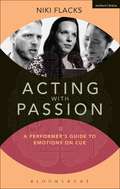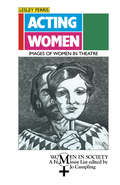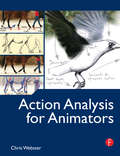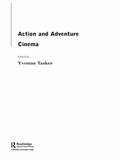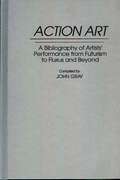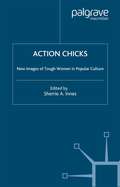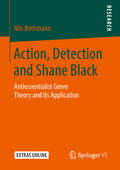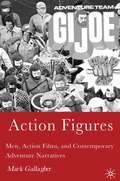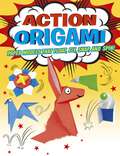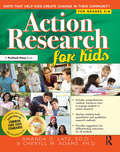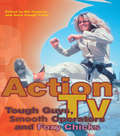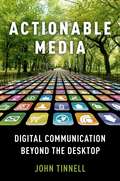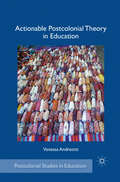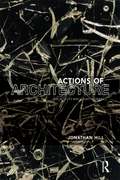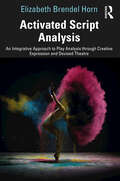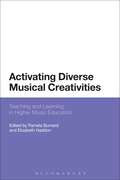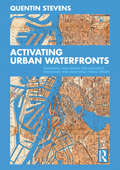- Table View
- List View
Acting with Passion: A Performer's Guide to Emotions on Cue (Performance Books)
by Niki FlacksBased on the latest research from the fields of neuroscience and mind-body psychology, Acting With Passion offers a revolutionary new approach to the age-old problems of the actor: dealing with nerves, engaging the body, quieting the inner critic, auditioning, creating a character, and even playing comedy. With this step-by-step guide, actors who have struggled with 'visualization' and 'emotional recall' can learn an alternative method of accessing feelings through the release of chronic, subtle muscular tensions that connect into the brain at lightning fast speed and can actually produce emotions on cue. Written with verve and accessibility, and using practical exercises to guide the actor through each stage, Acting With Passion is the must-have text for actors seeking that magical 'state of aliveness'.
Acting Women: Images of Women in Theatre (Women in Society: A Feminist List)
by Lesley FerrisFerris's book is as colourful and entertaining as it is informative... her revisionist study is a valuable contribution to the young but growing and crucial area of feminist approaches to theatre'. Gail Finney, University of California, Theatre Journal '...a highly readable account of cross-dressing on the stage from Ancient Greek times to the present day. The book is a thoroughly researched academic history but also includes her own analysis and commentary. This is a well written and informative analysis which deserves to attract a great deal of attention'. Keith Taylor, The Journal of National Drama
Action Analysis for Animators
by Chris WebsterAction Analysis is one of the fundamental princples of animation that underpins all types of animation: 2d, 3d, computer animation, stop motion, etc. This is a fundamental skill that all animators need to create polished, believable animation. An example of Action Analysis would be Shrek's swagger in the film, Shrek. The animators clearly understood (through action analysis) the type of walk achieved by a large and heavy individual (the real) and then applied their observations to the animated character of an ogre (the fantastic). It is action analysis that enabled the animation team to visually translate a real life situation into an ogre's walk, achieving such fantastic results.Key animation skills are demonstrated with in-depth illustrations, photographs and live action footage filmed with high speed cameras. Detailed Case Studies, practical assignments and industry interviews ground action analysis methodology with real life examples. Action Analysis for Animators is a essential guide for students, amateurs and professionals.
Action Analysis for Animators
by Chris WebsterAction Analysis is one of the fundamental princples of animation that underpins all types of animation: 2d, 3d, computer animation, stop motion, etc. This is a fundamental skill that all animators need to create polished, believable animation. An example of Action Analysis would be Shrek's swagger in the film, Shrek. The animators clearly understood (through action analysis) the type of walk achieved by a large and heavy individual (the real) and then applied their observations to the animated character of an ogre (the fantastic). It is action analysis that enabled the animation team to visually translate a real life situation into an ogre's walk, achieving such fantastic results.Key animation skills are demonstrated with in-depth illustrations, photographs and live action footage filmed with high speed cameras. Detailed Case Studies, practical assignments and industry interviews ground action analysis methodology with real life examples. Action Analysis for Animators is a essential guide for students, amateurs and professionals.
The Action and Adventure Cinema
by Yvonne TaskerThis exciting collection addresses action and adventure from the silent to the contemporary period exploring diverse questions of aesthetics, industry and ideology. Action has established itself as one of the leading commercial genres of the New Hollywood cinema, generating extensive debate in the process.Contributors consider how action might best be defined, how it has developed historically, and how it works formally. The critical reception and standing of action and adventure cinema is considered in relation to questions of national culture, violence and the 'art' of cinema.Themes explored include genre and definitions; early action, sensation and melodrama; authorship and action; national and transnational action-adventure traditions; action aesthetics; spectacle and narrative; stars and bodies; class; gender; race and ethnicity. Attempting to evaluate the significance of this type of filmmaking for both popular cinema and film studies, the book underlines the central place of action and adventure within film history.
The Action and Adventure Cinema
by Yvonne TaskerThis exciting collection addresses action and adventure from the silent to the contemporary period exploring diverse questions of aesthetics, industry and ideology. Action has established itself as one of the leading commercial genres of the New Hollywood cinema, generating extensive debate in the process.Contributors consider how action might best be defined, how it has developed historically, and how it works formally. The critical reception and standing of action and adventure cinema is considered in relation to questions of national culture, violence and the 'art' of cinema.Themes explored include genre and definitions; early action, sensation and melodrama; authorship and action; national and transnational action-adventure traditions; action aesthetics; spectacle and narrative; stars and bodies; class; gender; race and ethnicity. Attempting to evaluate the significance of this type of filmmaking for both popular cinema and film studies, the book underlines the central place of action and adventure within film history.
Action Art: A Bibliography of Artists' Performance from Futurism to Fluxus and Beyond (Art Reference Collection)
by John GrayThis comprehensive international bibliography is the first to attempt documentation of this diverse field, covering the history of Artist's Performance. It focuses on its early twentieth-century antecedents in such movements as Futurism, Dada, Russian Constructivism, and the Bauhaus as well as its peak period in the 1950s, 1960s, and 1970s with such developments as Gutai, Fluxus, Viennese Actionism, Situationism, and Guerrilla Art Action. Major emphasis is also given to sources on 115 individual performance artists and groups. More than 3700 entries document print and media materials dating from 1914 to 1992. Organized for maximum accessibility, the sources are also extensively cross-referenced and are indexed by artist, subject, title, and author. Three appendices identify reference works, libraries, and archives, and addenda material not found in the book text, and two others list artists by country and by group or collective.
Action Chicks: New Images of Tough Women in Popular Culture
by S. InnessXena, Buffy, Lara Croft. WWF, The Sopranos, Witchblade, La Femme Nikita. The women of pop culture are center stage and as tough as ever. Action Chicks is a groundbreaking collection highlighting the heroines we've grown to worship. What can they tell us about women in the Twent-first-century? What can they tell us about how popular culture depicts women? Do the characters escape traditional gender role expectations? Or do they adhere to sexual, racial, ethnic, and class stereotypes? The essays in Action Chicks provide fans with a new look at their favourite icons and their relationship to the popular media machine. A fascinating collection that's bound to stir up some excitement.
Action, Detection and Shane Black: Antiessentialist Genre Theory and Its Application
by Nils BothmannNils Bothmann applies antiessentialist genre theory to study the fusion of the action and the detection genre in the hybrid genre of detAction, focusing on the work of screenwriter and director Shane Black. After providing antiessentialist definitions of all three genres, the author undertakes close readings of Black’s work in order to analyze depictions of race and gender as well as the role of intermediality and genre hybridity in detAction.
Action Figures: Men, Action Films, and Contemporary Adventure Narratives
by M. GallagherWhat accounts for the massive global popularity of action films and adventure literature? How do men and women respond to iconic screen stars such as Jackie Chan, Arnold Schwarzenegger, Steve McQueen, and Charlton Heston? Action genres have been Hollywood's most profitable global exports for most of its history, their male heroes the subject of much fascination and derision. Bestselling literary thrillers, from The Hunt for Red October to Into Thin Air , have also contributed markedly to popular understandings of male activity. Action Figures takes stock of action narratives' many appeals and recognizes how contemporary crises of gender identity manifest themselves in popular commercial texts.
Action Origami: Paper Models That Snap, Bang, Fly And Spin!
by Belinda Webster Joe FullmanDiscover how to turn a simple square of paper into something ACTION-PACKED!From flapping birds to floating boats, spinning tops to magic wands, and barking dogs to jumping horses, this book is filled with amazing paper models for you to create. The great photography and clear, step-by-step instructions make each project really easy to master and lots of fun to fold.
Action Research for Kids: Units That Help Kids Create Change in Their Community (Grades 5-8)
by Amanda O. Latz Cheryll AdamsAction Research for Kids provides teachers with comprehensive, creative, and hands-on units to engage students in action research. Students will benefit from learning about quantitative and qualitative research practices that can make a real difference in their lives and those within their communities. Within this text, teachers can select a lesson or use whole units as students explore research methods such as survey research, experimental research, life history, and photovoice in fun lessons that ask them to create a library wish list, interview people in their communities, lobby for cookies in the cafeteria, and experiment with preservatives. Each lesson comes with detailed instructions and ideas for differentiation. Grades 5-8
Action Research for Kids: Units That Help Kids Create Change in Their Community (Grades 5-8)
by Amanda O. Latz Cheryll AdamsAction Research for Kids provides teachers with comprehensive, creative, and hands-on units to engage students in action research. Students will benefit from learning about quantitative and qualitative research practices that can make a real difference in their lives and those within their communities. Within this text, teachers can select a lesson or use whole units as students explore research methods such as survey research, experimental research, life history, and photovoice in fun lessons that ask them to create a library wish list, interview people in their communities, lobby for cookies in the cafeteria, and experiment with preservatives. Each lesson comes with detailed instructions and ideas for differentiation. Grades 5-8
Action TV: Tough-Guys, Smooth Operators and Foxy Chicks
by Anna Gough-Yates Bill Osgerby Anna Gough YatesFrom re-runs of 'TV classics' like The Avengers or Starsky and Hutch, to soundtracks, club nights and film remakes such as Mission Impossible II, the action series is enjoying a popular revival. Yet little attention has been paid to the history, nature and enduring appeal of the action series, and its place in popular culture, past and present.Action TV traces the development of the action series from its genesis in the 1950s. From The Saint to Knigh t Rider, contributors explore the key shows which defined the genre, addressing issues of audiences and consumption, gender and sexuality, fashion and popular culture. They examine the institutional and cultural factors influencing the action series, and relate shifts in the genre to other forms of popular culture including film, pop music, fashion and popular literature.Chapters include:* Of leather suits and kinky boots: The Avengers, style and popular culture* 'Who loves ya, baby?': Kojak, action and the great society*'A lone crusader in a dangerous world': heroics of science and technology in Knight Rider* Angels in chains? feminism, femininity and consumer culture in Charlie's Angels* 'Who's the cat that won't cop out?' Black masculinity in American action shows of the sixties and seventies
Action TV: Tough-Guys, Smooth Operators and Foxy Chicks
by Bill Osgerby Anna Gough-YatesFrom re-runs of 'TV classics' like The Avengers or Starsky and Hutch, to soundtracks, club nights and film remakes such as Mission Impossible II, the action series is enjoying a popular revival. Yet little attention has been paid to the history, nature and enduring appeal of the action series, and its place in popular culture, past and present.Action TV traces the development of the action series from its genesis in the 1950s. From The Saint to Knigh t Rider, contributors explore the key shows which defined the genre, addressing issues of audiences and consumption, gender and sexuality, fashion and popular culture. They examine the institutional and cultural factors influencing the action series, and relate shifts in the genre to other forms of popular culture including film, pop music, fashion and popular literature.Chapters include:* Of leather suits and kinky boots: The Avengers, style and popular culture* 'Who loves ya, baby?': Kojak, action and the great society*'A lone crusader in a dangerous world': heroics of science and technology in Knight Rider* Angels in chains? feminism, femininity and consumer culture in Charlie's Angels* 'Who's the cat that won't cop out?' Black masculinity in American action shows of the sixties and seventies
Actionable Media: Digital Communication Beyond the Desktop
by John TinnellIn 1991, Mark Weiser and his team at Xerox PARC declared they were reinventing computers for the twenty-first century. The computer would become integrated into the fabric of everyday life; it would shift to the background rather than being itself an object of focus. The resulting rise of ubiquitous computing (smartphones, smartglasses, smart cities) have since thoroughly colonized our digital landscape. In Actionable Media, John Tinnell contends that there is an unsung rhetorical dimension to Weiser's legacy, which stretches far beyond recent iProducts. Taking up Weiser's motto, "Start from the arts and humanities," Tinnell develops a theoretical framework for understanding nascent initiatives--the Internet of things, wearable interfaces, augmented reality--in terms of their intellectual history, their relationship to earlier communication technologies, and their potential to become vibrant platforms for public culture and critical media production. It is clear that an ever-widening array of everyday spaces now double as venues for multimedia authorship. Writers, activists, and students, in cities and towns everywhere, are digitally augmenting physical environments. Audio walks embed narratives around local parks for pedestrians to encounter during a stroll; online forums are woven into urban infrastructure and suburban plazas to invigorate community politics. This new wave of digital communication, which Tinnell terms "actionable media," is presented through case studies of exemplar projects by leading artists, designers, and research-creation teams. Chapters alter notions of ubiquitous computing through concepts drawn from Bernard Stiegler, Gregory Ulmer, and Hannah Arendt; from comparative media analyses with writing systems such as cuneiform, urban signage, and GUI software; and from relevant stylistic insights gleaned from the open air arts practices of Augusto Boal, Claude Monet, and Janet Cardiff. Actionable Media challenges familiar claims about the combination of physical and digital spaces, beckoning contemporary media studies toward an alternative substrate of historical precursors, emerging forms, design philosophies, and rhetorical principles.
ACTIONABLE MEDIA C: Digital Communication Beyond the Desktop
by John TinnellIn 1991, Mark Weiser and his team at Xerox PARC declared they were reinventing computers for the twenty-first century. The computer would become integrated into the fabric of everyday life; it would shift to the background rather than being itself an object of focus. The resulting rise of ubiquitous computing (smartphones, smartglasses, smart cities) have since thoroughly colonized our digital landscape. In Actionable Media, John Tinnell contends that there is an unsung rhetorical dimension to Weiser's legacy, which stretches far beyond recent iProducts. Taking up Weiser's motto, "Start from the arts and humanities," Tinnell develops a theoretical framework for understanding nascent initiatives--the Internet of things, wearable interfaces, augmented reality--in terms of their intellectual history, their relationship to earlier communication technologies, and their potential to become vibrant platforms for public culture and critical media production. It is clear that an ever-widening array of everyday spaces now double as venues for multimedia authorship. Writers, activists, and students, in cities and towns everywhere, are digitally augmenting physical environments. Audio walks embed narratives around local parks for pedestrians to encounter during a stroll; online forums are woven into urban infrastructure and suburban plazas to invigorate community politics. This new wave of digital communication, which Tinnell terms "actionable media," is presented through case studies of exemplar projects by leading artists, designers, and research-creation teams. Chapters alter notions of ubiquitous computing through concepts drawn from Bernard Stiegler, Gregory Ulmer, and Hannah Arendt; from comparative media analyses with writing systems such as cuneiform, urban signage, and GUI software; and from relevant stylistic insights gleaned from the open air arts practices of Augusto Boal, Claude Monet, and Janet Cardiff. Actionable Media challenges familiar claims about the combination of physical and digital spaces, beckoning contemporary media studies toward an alternative substrate of historical precursors, emerging forms, design philosophies, and rhetorical principles.
Actionable Postcolonial Theory in Education (Postcolonial Studies in Education)
by V. AndreottiAndreotti illustrates how postcolonial theory is applied in the contexts of educational research/critique and in pioneering pedagogical projects. She offers an accessible and useful overview and comparison of theoretical debates related to critiques of Western/Northern hegemony.
Actions of Architecture: Architects and Creative Users
by Jonathan HillDrawing on the work of a wide range of architects, artists and writers, this book considers the relations between the architect and the user, which it compares to the relations between the artist and viewer and the author and reader. The book's thesis is informed by the text 'The Death of the Author', in which Roland Barthes argues for a writer aware of the creativity of the reader. Actions of Architecture begins with a critique of strategies that define the user as passive and predictable, such as contemplation and functionalism. Subsequently it considers how an awareness of user creativity informs architecture, architects and concepts of authorship in architectural design. Identifying strategies that recognize user creativity, such as appropriation, collaboration, disjunction, DIY, montage, polyvalence and uselessness, Actions of Architecture states that the creative user should be the central concern of architectural design.
Actions of Architecture: Architects and Creative Users
by Jonathan HillDrawing on the work of a wide range of architects, artists and writers, this book considers the relations between the architect and the user, which it compares to the relations between the artist and viewer and the author and reader. The book's thesis is informed by the text 'The Death of the Author', in which Roland Barthes argues for a writer aware of the creativity of the reader. Actions of Architecture begins with a critique of strategies that define the user as passive and predictable, such as contemplation and functionalism. Subsequently it considers how an awareness of user creativity informs architecture, architects and concepts of authorship in architectural design. Identifying strategies that recognize user creativity, such as appropriation, collaboration, disjunction, DIY, montage, polyvalence and uselessness, Actions of Architecture states that the creative user should be the central concern of architectural design.
Activated Script Analysis: An Integrative Approach to Play Analysis through Creative Expression and Devised Theatre
by Elizabeth Brendel HornActivated Script Analysis engages theatre students in traditional formative script analysis through a fusion of devised theatre and various modes of creative expression, dispelling the notion of script analysis as an isolated pen-to-paper task and reimagining it as a captivating and collaborative process. This book uses diverse, contemporary plays to model the script analysis process for each of four Theatrical Elements: Given Circumstances; Character; Setting; and Structure. By considering each of these elements, readers can uncover patterns and themes within a dramatic text. Woven throughout the study of each theatrical element are "Connections": Personal Connections, which encourage readers to explore a theatrical element within their own lives, as though their lives were a script; Play Connections, which make abstract ideas presented in script analysis concrete through theatre-based play; Professional Connections, which examine how a theatre professional might analyze a script within their own work; and Performative Connections, which provide the opportunity for students to explore a theatrical element through performance using devised theatre strategies. At the end of each chapter, readers are given the opportunity to analyze a text through the lens of a Theatrical Element and to express their findings through a variety of digital, written, visual, and performance-based modes of expression. Activated Script Analysis is designed for undergraduate theatre students and educators, to be used as the primary text in Script Analysis coursework or as a supplemental text in Acting or Directing courses. The book includes access to downloadable templates and example videos, available at www.routledge.com/9781032125398.
Activated Script Analysis: An Integrative Approach to Play Analysis through Creative Expression and Devised Theatre
by Elizabeth Brendel HornActivated Script Analysis engages theatre students in traditional formative script analysis through a fusion of devised theatre and various modes of creative expression, dispelling the notion of script analysis as an isolated pen-to-paper task and reimagining it as a captivating and collaborative process. This book uses diverse, contemporary plays to model the script analysis process for each of four Theatrical Elements: Given Circumstances; Character; Setting; and Structure. By considering each of these elements, readers can uncover patterns and themes within a dramatic text. Woven throughout the study of each theatrical element are "Connections": Personal Connections, which encourage readers to explore a theatrical element within their own lives, as though their lives were a script; Play Connections, which make abstract ideas presented in script analysis concrete through theatre-based play; Professional Connections, which examine how a theatre professional might analyze a script within their own work; and Performative Connections, which provide the opportunity for students to explore a theatrical element through performance using devised theatre strategies. At the end of each chapter, readers are given the opportunity to analyze a text through the lens of a Theatrical Element and to express their findings through a variety of digital, written, visual, and performance-based modes of expression. Activated Script Analysis is designed for undergraduate theatre students and educators, to be used as the primary text in Script Analysis coursework or as a supplemental text in Acting or Directing courses. The book includes access to downloadable templates and example videos, available at www.routledge.com/9781032125398.
Activating Diverse Musical Creativities: Teaching and Learning in Higher Music Education
by Pamela Burnard Elizabeth HaddonActivating Diverse Musical Creativities analyses the ways in which music programmes in higher education can activate and foster diverse musical creativities. It also demonstrates the relationship between musical creativities and entrepreneurship in higher education teaching and learning. These issues are of vital significance to contemporary educational practice and training in both university and conservatoire contexts, particularly when considered alongside the growing importance of entrepreneurship, defined here as a type of creativity, for successful musicians working in the 21st century creative and cultural industries. International contributors address a broad spectrum of musical creativities in higher education, such as improvisational creativity, empathic creativity and leadership creativity, demonstrating the transformative possibilities of embedding these within higher music education teaching and learning. The chapters explore the active practice of musical creativities in teaching and learning and recognize their mutual dependency. The contributors consider philosophical and practical concerns in their work on teaching for creativity in higher music education and focus on practices using imaginative approaches in order to make learning more interesting, effective and relevant.
Activating Diverse Musical Creativities: Teaching and Learning in Higher Music Education
by Edited by Pamela Burnard Elizabeth HaddonActivating Diverse Musical Creativities analyses the ways in which music programmes in higher education can activate and foster diverse musical creativities. It also demonstrates the relationship between musical creativities and entrepreneurship in higher education teaching and learning. These issues are of vital significance to contemporary educational practice and training in both university and conservatoire contexts, particularly when considered alongside the growing importance of entrepreneurship, defined here as a type of creativity, for successful musicians working in the 21st century creative and cultural industries. International contributors address a broad spectrum of musical creativities in higher education, such as improvisational creativity, empathic creativity and leadership creativity, demonstrating the transformative possibilities of embedding these within higher music education teaching and learning. The chapters explore the active practice of musical creativities in teaching and learning and recognize their mutual dependency. The contributors consider philosophical and practical concerns in their work on teaching for creativity in higher music education and focus on practices using imaginative approaches in order to make learning more interesting, effective and relevant.
Activating Urban Waterfronts: Planning and Design for Inclusive, Engaging and Adaptable Public Spaces
by Quentin StevensActivating Urban Waterfronts shows how urban waterfronts can be designed, managed and used in ways that can make them more inclusive, lively and sustainable. The book draws on detailed examination of a diversity of waterfronts from cities across Europe, Australia and Asia, illustrating the challenges of connecting these waterfront precincts to the surrounding city and examining how well they actually provide connection to water. The book challenges conventional large scale, long-term approaches to waterfront redevelopment, presenting a broad re-thinking of the formats and processes through which urban redevelopment can happen. It examines a range of actions that transform and activate urban spaces, including informal appropriations, temporary interventions, co-design, creative programming of uses, and adaptive redevelopment of waterfronts over time. It will be of interest to anyone involved in the development and management of waterfront precincts, including entrepreneurs, the creative industries, community organizations, and, most importantly, ordinary users.
